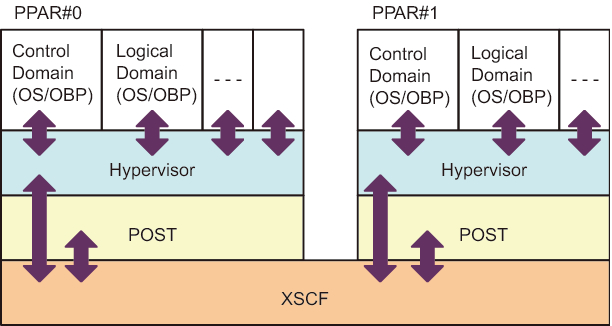10.4.1 Understanding the Mechanism of the Host Watchdog Function/Alive Check
10.4.1 Understanding the Mechanism of the Host Watchdog Function/Alive Check
An Oracle Solaris logical domain, OpenBoot PROM, Hypervisor, POST, and the XSCF communicate with one another and mutually monitor the alive status. Upon detection of any failure, a panic is generated or they are individually stopped to prevent the effect of the failure from spreading.
In these systems, Hypervisor monitors the logical domain/OpenBoot PROM, and the XSCF monitors POST.
The mechanism of monitoring between Hypervisor and the logical domain and between Hypervisor and OpenBoot PROM is called the Host watchdog function. Also the mechanism of monitoring between XSCF and POST is called the Alive check function.
In these systems, Hypervisor monitors the logical domain/OpenBoot PROM, and the XSCF monitors POST.
The mechanism of monitoring between Hypervisor and the logical domain and between Hypervisor and OpenBoot PROM is called the Host watchdog function. Also the mechanism of monitoring between XSCF and POST is called the Alive check function.
Figure 10-4 shows the respective resources monitoring one another.
|
Figure 10-4 System Monitoring Feature
|

|
| Note - OBP in Figure 10-4 stands for OpenBoot PROM. |
XSCF monitors POST and judges as a failure when there is no response after a specific elapsed time, and then resets the physical partition or turns off the power.
Hypervisor regularly monitors the operation status of logical domains (Oracle Solaris/OpenBoot PROM) to detect any Oracle Solaris hang-up. Upon detecting an Oracle Solaris hang-up, Hypervisor generates an Oracle Solaris panic in the relevant domain.
Hypervisor regularly monitors the operation status of logical domains (Oracle Solaris/OpenBoot PROM) to detect any Oracle Solaris hang-up. Upon detecting an Oracle Solaris hang-up, Hypervisor generates an Oracle Solaris panic in the relevant domain.
| Note - For support information on the Alive check function between the XSCF and Hypervisor, which is set up by the setpparmode command, see the latest Product Notes for your server. |
< Previous Page | Next Page >